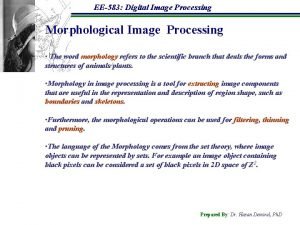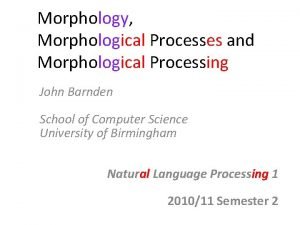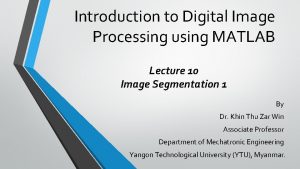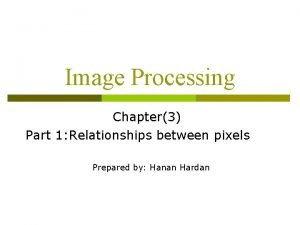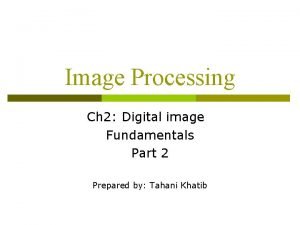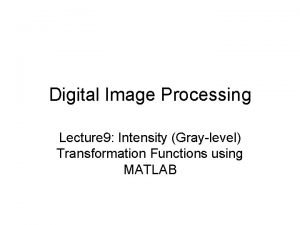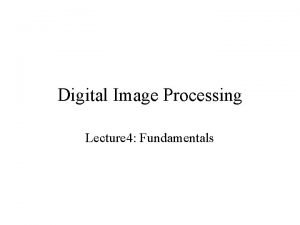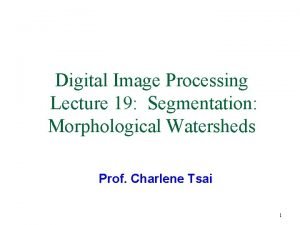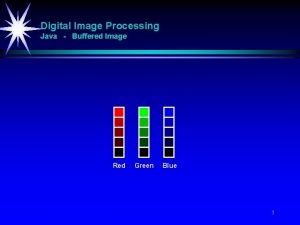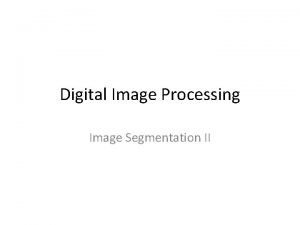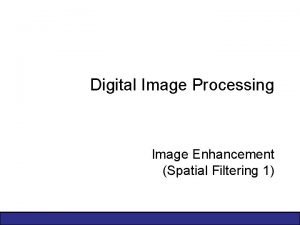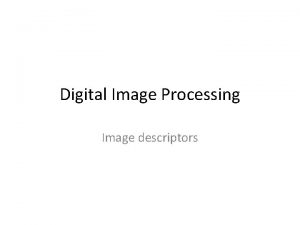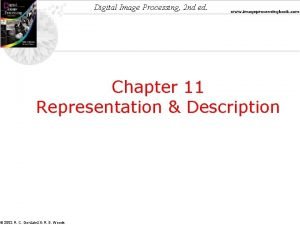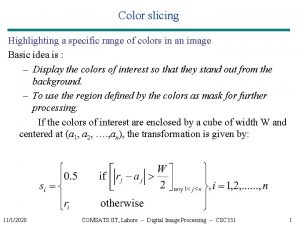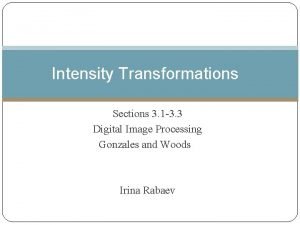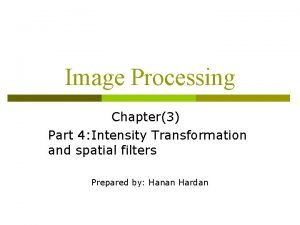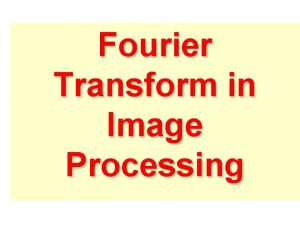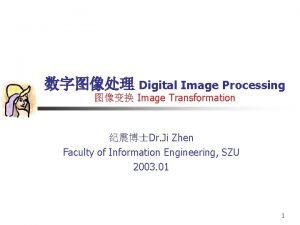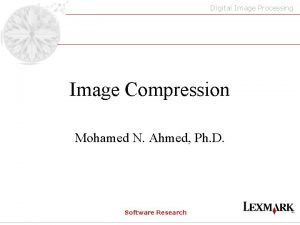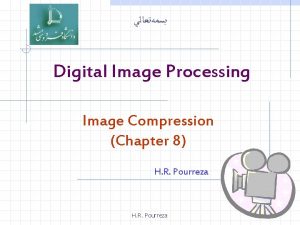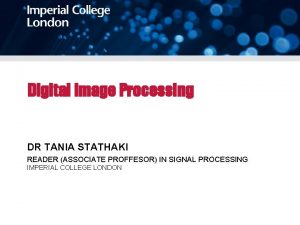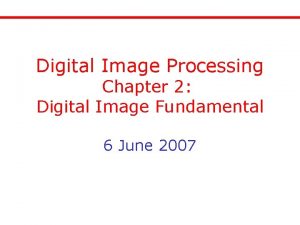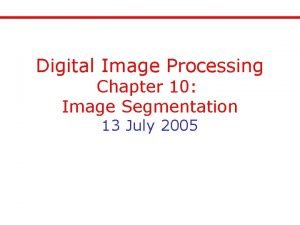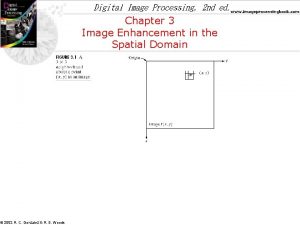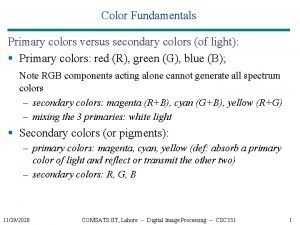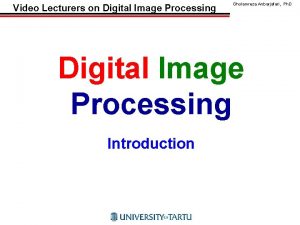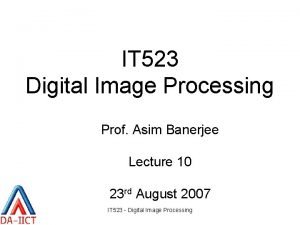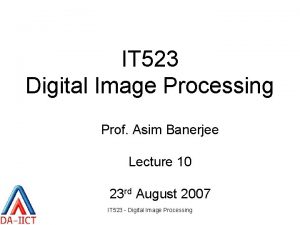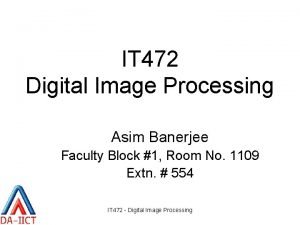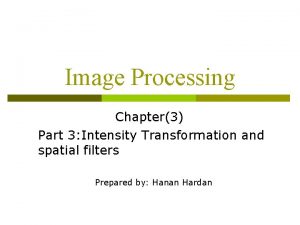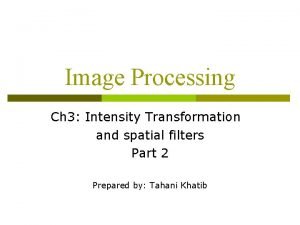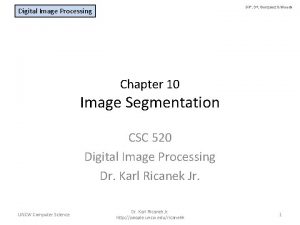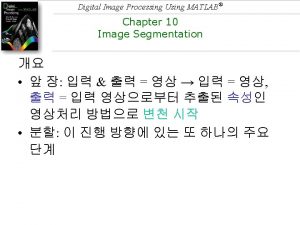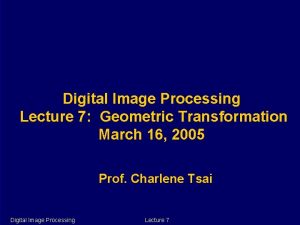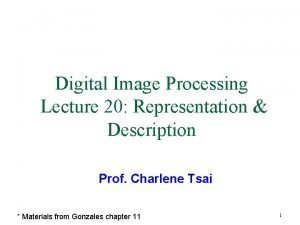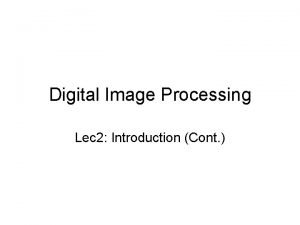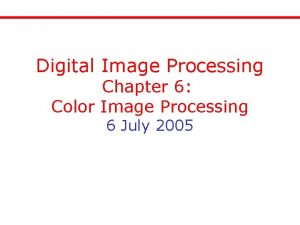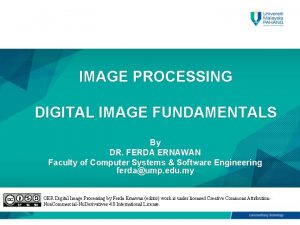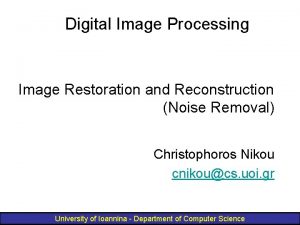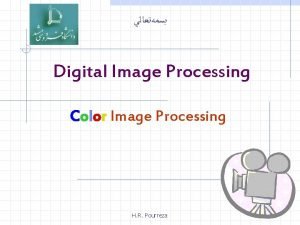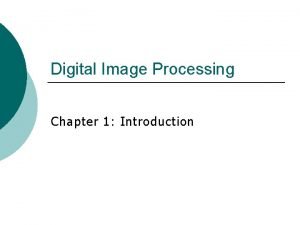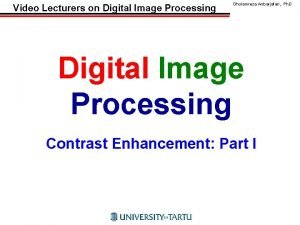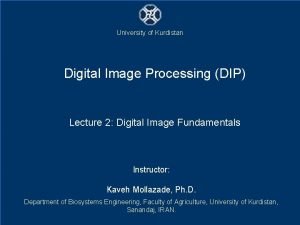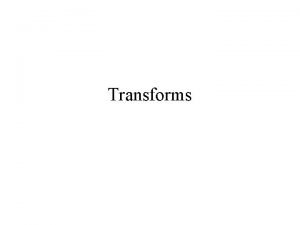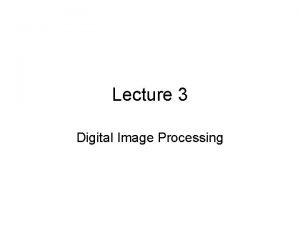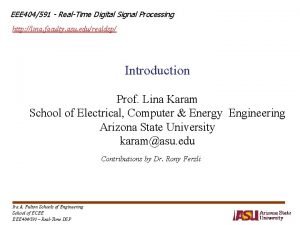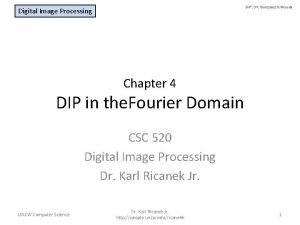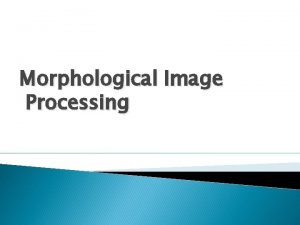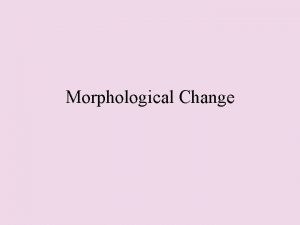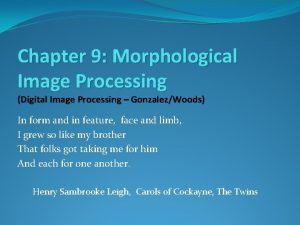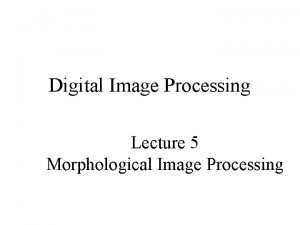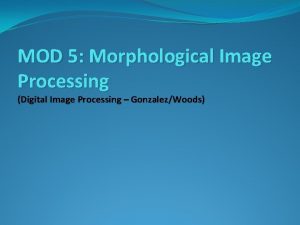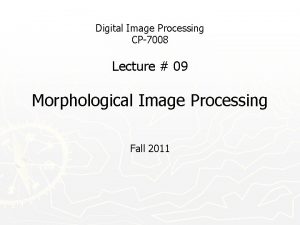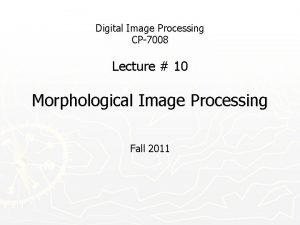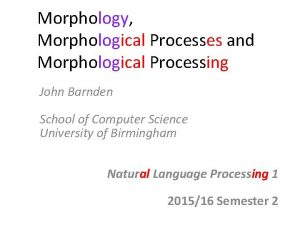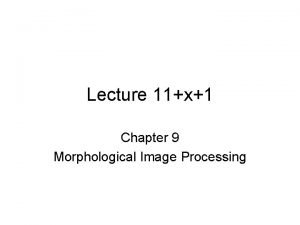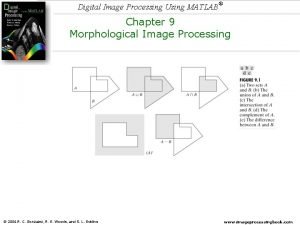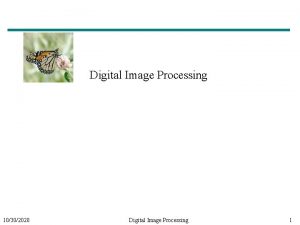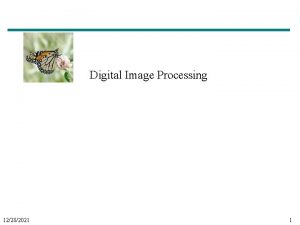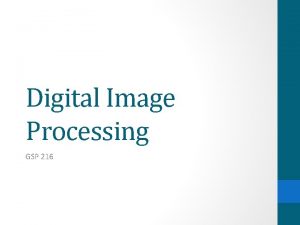Digital Image Processing Chapter 9 Morphological Image Processing












































































- Slides: 76

Digital Image Processing Chapter 9 : Morphological Image Processing

http: //mips. changwon. ac. kr 1

Contents PART 1 q q q Preview Preliminaries Dilation and Erosion Opening and Closing The Hit-or-Miss Transformation PART 2 q q Some Basic Morphological Algorithms Extensions to Gray-Scale Images Summary References http: //mips. changwon. ac. kr 2

Preview q “Morphology” - a branch of biology that deals with the shape, form and structure of animals and plants. q Mathematical morphology is a tool for extracting image components that are useful in the representation and description of region shape, such as boundaries, skeletons, and convex hull q Morphological Techniques for pre- or post processing morphological filtering, thinning and pruning. http: //mips. changwon. ac. kr 3

q Morphology is a cornerstone of the mathematical set of tools underlying the development of techniques that extract “meaning” from an image. q Mathematical framework used for: v Pre-processing - noise filtering, shape simplification, v Enhancing object structure - skeletonization, convex hull v Segmentation - watershed v Quantitative description - area, perimeter, . . . http: //mips. changwon. ac. kr 4

Preliminaries http: //mips. changwon. ac. kr 5

Basic concepts from Set Theory • The language of mathematical morphology is Set Theory • In binary images, the set elements are members of the 2 -D integer space Z 2 Where each element (x, y) is a coordinate of black (or white) pixel in the image. • “Union” of two sets A and B – The set of elements belonging to A, B, or both • “Intersection” of two sets A and B – The set of elements belonging to both A and B • W “is an element of” set A http: //mips. changwon. ac. kr 6

Basic concepts from Set Theory (Cont. ) http: //mips. changwon. ac. kr 7

Basic operations of Set Theory- I http: //mips. changwon. ac. kr 8

Basic operations of Set Theory- II • The reflection of a set B • The translation of set A by point z= (Z 1, Z 2) Translation of set A by z Set B Reflection of set B http: //mips. changwon. ac. kr 9

Logical operators and sets http: //mips. changwon. ac. kr 10

Example - I http: //mips. changwon. ac. kr 11

Example -II http: //mips. changwon. ac. kr 12

Structure Elements (SE) • Small sets or sub-images used to probe an image under study for properties of interest. http: //mips. changwon. ac. kr 13

Dilation and Erosion http: //mips. changwon. ac. kr 14

Dilation • Dilation is an operation that “grows” and “thickens” objects in an image. • The specific manner and extent of this thickening is controlled by a shape referred • to as a structuring element. The dilation of A by B, is defined as the set operation where, ∅ is the empty set and B is the structuring element • In words, the dilation of A by B is the set consisting of all the structuring element origin locations where the reflected and translated B overlaps at least one element of A http: //mips. changwon. ac. kr 15

Working of Dilation The output image is 1 at each location of the origin of the structuring element such that structuring element overlaps at least one 1 - valued pixel in the input image. http: //mips. changwon. ac. kr 16

Example http: //mips. changwon. ac. kr 17

Erosion • Erosion “shrinks” or “thins” objects in a binary image. • As a dilation , the manner and extent of shrinking is controlled by a structuring element. • The erosion of A by B , is defined as where, the notation (B)z⊆A means that (B)z is subset of A. • In words, erosion of A by B is the set of all points z such that B, translated by z , is contained in A. http: //mips. changwon. ac. kr 18

Working of Erosion • The output image has a value of 1 at each location of the origin of the structuring element such that the element overlap only 1 (not 0)valued pixels of the input image. http: //mips. changwon. ac. kr 19

Example http: //mips. changwon. ac. kr 20

Combining Erosion and Dilation q Dilation and erosion are duals of each other with respect to set complementation and reflection. q Wanted • remove structures / fill holes • without affecting remaining parts q Solution • combine erosion and dilation • (using same SE) http: //mips. changwon. ac. kr 21

Example of combining Erosion and Dilation Structuring element B=13 x 13 pixels http: //mips. changwon. ac. kr 22

Opening and Closing http: //mips. changwon. ac. kr 23

Opening and Closing • Opening smoothes the contour of an object, breaks thin connections and removes thin protrusions. • Closing generally joins narrow breaks, fills long thin gulfs, and fills holes smaller than the structuring element. http: //mips. changwon. ac. kr 24

Example Opening and closing are duals of each other with respect to set complementation and reflection. http: //mips. changwon. ac. kr 25

Morphological Filter • Morphological operations can be used to construct filters which are similar in concept to spatial filters. • A Morphological filter consisting of opening followed by closing can be used to eliminate the noise and its effect on the print. http: //mips. changwon. ac. kr 26

The Hit-or-Miss Transformation http: //mips. changwon. ac. kr 27

The Hit-or-Miss Transformation • A basic morphological tool for shape detection or template matching • Let the origin of each shape be located at its center of gravity. • If we want to find the location of a shape , say – X , at (larger) image, say – A : – Let X be enclosed by a small window, say – W. – The local background of X with respect to W is defined as the set difference (W - X). – Apply erosion operator of A by X, will get us the set of locations of the origin of X, such that X is completely contained in A. – It may be also view geometrically as the set of all locations of the origin of X at which X found a match (hit) in A. – Apply erosion operator on the complement of A by the local background set (W – X). – Notice, that the set of locations for which X exactly fits inside A is the intersection of these two last operators above. This intersection is precisely the location sought. http: //mips. changwon. ac. kr 28

The Hit-or-Miss Transformation http: //mips. changwon. ac. kr 29

Working of Hit-or-Miss Transformation http: //mips. changwon. ac. kr 30

The Hit-or-Miss Transformation - Example http: //mips. changwon. ac. kr 31

Basic Morphological Algorithms http: //mips. changwon. ac. kr 32

Basic Morphological Algorithms 1. 2. 3. 4. 5. 6. 7. 8. Boundary Extraction Region filling Extraction of connected components Convex hull Thinning Thickening Skeletons Pruning http: //mips. changwon. ac. kr 33

1. Boundary Extraction Ø First, erode A by B, then make set difference between A and the Ø erosion The thickness of the contour depends on the size of structuring element – B http: //mips. changwon. ac. kr 34

1. Boundary Extraction- Example http: //mips. changwon. ac. kr 35

2. Region Filling Ø This algorithm is based on a set of dilations, complementation and intersections Ø Lets consider a set A containing a subset whose elements are 8 - connected boundary points of a region Ø p is the point inside the boundary, with the value of 1 Ø The process stops when X(k) = X(k-1) Ø The result that given by union of X(k) and A , is a set contains the filled set and the boundary http: //mips. changwon. ac. kr 36

2. Region Filling-Working http: //mips. changwon. ac. kr 37

2. Region Filling-Example II http: //mips. changwon. ac. kr 38

3. Extraction of Connected Components Ø This algorithm extracts a component by selecting a point on a binary object A Ø Works similar to region filling, but this time we use in the conjunction the Ø Ø Ø object A, instead of it’s complement Let Y represent a connected component contained in a set A Assume a point “p” of Y is known Below equation yields all the elements of Y : Where X 0=p and B is suitable structuring element http: //mips. changwon. ac. kr 39

3. Extraction of Connected Components - Working http: //mips. changwon. ac. kr 40

3. Extraction of Connected Components. Example This shows automated inspection of chicken-breast, that contains bone fragment The original image is threshold We can get by using this algorithm the number of pixels in each of the connected components Now we could know if this food contains big enough bones and prevent hazards http: //mips. changwon. ac. kr 41

4. Convex Hull Ø Set A is said to be convex if a straight line segment joining any two points in A lies entirely within A Ø The convex hull H of set S is the smallest convex set containing S Ø Useful for object description Ø This algorithm iteratively applying the hit-or-miss transform to A with the first of B element, unions it with A, and repeated with second element of B http: //mips. changwon. ac. kr 42

4. Convex Hull - Working http: //mips. changwon. ac. kr 43

4. Convex Hull – Working (Cont. ) http: //mips. changwon. ac. kr 44

4. Convex Hull - Example http: //mips. changwon. ac. kr 45

5. Thinning Ø The thinning of a set A by a structuring element B, can be defined by terms of the hit-and-miss transform: Ø A more useful expression for thinning A symmetrically is based on a sequence of structuring elements: {B}={B 1, B 2, B 3, …, Bn} Ø Where Bi is a rotated version of Bi-1. Using this concept we define thinning by a sequence of structuring elements: Ø The process is to thin by one pass with B 1 , then thin the result with one pass Ø Ø with B 2, and so on until A is thinned with one pass with Bn. The entire process is repeated until no further changes occur. Each pass is preformed using the equation http: //mips. changwon. ac. kr 46

5. Thinning- Working http: //mips. changwon. ac. kr 47

5. Thinning- Example http: //mips. changwon. ac. kr 48

6. Thickening Ø Thickening is a morphological dual of thinning. Ø Definition of thickening Ø As in thinning, thickening can be defined as a sequential operation: Ø the structuring elements used for thickening have the same form as in thinning, but with all 1’s and 0’s interchanged. Ø A separate algorithm for thickening is often used in practice, Instead the usual procedure is to thin the background of the set in question and then complement the result. Ø In other words, to thicken a set A, we form C=Ac , thin C and than form Cc. http: //mips. changwon. ac. kr 49

6. Thickening - Working Ø We will notice in the next example 9. 22(c) that the thinned background forms a boundary for the thickening process, this feature does not occur in the direct implementation of thickening Ø This is one of the reasons for using background thinning to accomplish thickening. http: //mips. changwon. ac. kr 50

6. Thickening - Example Original http: //mips. changwon. ac. kr Thick 51

7. Skeleton ØThe notion of a skeleton S(A) of a set A is intuitively defined, we deduce from this figure that: • If z is a point of S(A) and (D)z is the largest disk centered in z and contained in A (one cannot find a larger disk that fulfils this terms) – this disk is called “maximum disk” • The disk (D)z touches the boundary of A at two or more different places. http: //mips. changwon. ac. kr 52

7. Skeleton (Cont. ) Ø The skeleton of A is defined by terms of erosions and openings: With Where B is the structuring element and of A: – • • • – indicates k successive erosions k times, and K is the last iterative step before A erodes to an empty set, in other words: in conclusion S(A) can be obtained as the union of skeleton subsets Sk(A). http: //mips. changwon. ac. kr 53

7. Skeleton - Working http: //mips. changwon. ac. kr 54

7. Skeleton - Example http: //mips. changwon. ac. kr 55

8. Pruning Ø Pruning methods are essential complement to thinning and skeletonizing algorithms because tend to leave parasitic components that need to be “cleaned up” by post processing http: //mips. changwon. ac. kr 56

8. Pruning - Example http: //mips. changwon. ac. kr 57

Summary of Morphological Operations on Binary Image http: //mips. changwon. ac. kr 58

Summary of Morphological Operations on Binary Image (Cont. ) http: //mips. changwon. ac. kr 59

Summary of morphological results and their properties http: //mips. changwon. ac. kr 60

Summary of morphological results and their properties http: //mips. changwon. ac. kr 61

Basic Types of Structuring Elements http: //mips. changwon. ac. kr 62

Extensions to Gray-Scale Images http: //mips. changwon. ac. kr 63

Gray-Scale Images Ø In gray scale images on the contrary to binary images we deal with digital Ø Ø Ø image functions of the form f(x, y) as an input image and b(x, y) as a structuring element. (x, y) are integers from Z*Z that represent a coordinates in the image. f(x, y) and b(x, y) are functions that assign gray level value to each distinct pair of coordinates. For example the domain of gray values can be 0 -255, whereas 0 – is black, 255 - is white. http: //mips. changwon. ac. kr 64

1. Dilation – Gray-Scale Ø Equation for gray-scale dilation is: Ø Df and Db are domains of f and b. Ø The condition that (s-x), (t-y) need to be in the domain of f and x, y in the Ø domain of b, is analogous to the condition in the binary definition of dilation, where the two sets need to overlap by at least one element. We will illustrate the previous equation in terms of 1 -D. and we will receive an equation for 1 variable: Ø The requirements the (s-x) is in the domain of f and x is in the domain of b Ø Ø imply that f and b overlap by at least one element. Unlike the binary case, f, rather than the structuring element b is shifted. Conceptually f sliding by b is really not different than b sliding by f. http: //mips. changwon. ac. kr 65

1. Dilation – Gray-Scale (Cont. ) Ø The general effects of performing dilation on a gray scale image is twofold: a. If all the values of the structuring elements are positive, then the output image tends to be brighter than the input. b. Dark details either are reduced or eliminated, depending on how their values and shape relate to the structuring element used for dilation http: //mips. changwon. ac. kr 66

2. Erosion – Gray-Scale Ø Gray-scale erosion is defined as: Ø The condition that (s+x), (t+y) have to be in the domain of f, and x, y have to be in the Ø domain of b, is completely analogous to the condition in the binary definition of erosion, where the structuring element has to be completely combined by the set being eroded. The same as in erosion we illustrate with 1 -D function Ø General effect of performing an erosion in grayscale images: If all elements of the structuring element are positive, the output image tends to be darker than the input image. v The effect of bright details in the input image that are smaller in area than the structuring element is reduced, with the degree of reduction being determined by the grayscale values surrounding by the bright detail and by shape and amplitude values of the structuring element itself. Similar to binary image grayscale erosion and dilation are duals with respect to function complementation and reflection v Ø http: //mips. changwon. ac. kr 67

2. Erosion – Gray-Scale http: //mips. changwon. ac. kr 68

Example of Dilation & Erosion – Gray-Scale http: //mips. changwon. ac. kr 69

Example of Dilation & Erosion – Gray-Scale http: //mips. changwon. ac. kr 70

3. Opening & Closing Ø Similar to the binary algorithms Ø Opening – Ø Closing – Ø In the opening of a gray-scale image, we remove small light details, Ø while relatively undisturbed overall gray levels and larger bright features In the closing of a gray-scale image, we remove small dark details, while relatively undisturbed overall gray levels and larger dark features http: //mips. changwon. ac. kr 71

3. Opening & Closing (cont. ) Ø Opening a G-S picture is describable as pushing object B under the scan-line graph, while traversing the graph according the curvature of B Ø Closing a G-S picture is describable as pushing object B on top of the scan-line graph, while traversing the graph according the curvature of B Ø The peaks are usually remains in their original form http: //mips. changwon. ac. kr 72

3. Opening & Closing - Example http: //mips. changwon. ac. kr 73

Summary Ø The morphological concepts and techniques constitutes a powerful set of tools for extracting features of interest in an image. Ø Morphological techniques have evolved from set-theory. Ø Dilation and erosion are primitive operations that are the basis for morphological algorithms. Ø Morphology cab be used as the basis for developing image segmentations procedures with a wide range of applications. http: //mips. changwon. ac. kr 74

References • Digital Image Processing Second Edition by Rafael C. Gonzalez , Richard E. Woods • Digital Image Processing using MATLAB by Rafael Gonzalez , Richard Woods, Steven Eddins http: //mips. changwon. ac. kr 75
 Thinning and thickening in image processing example
Thinning and thickening in image processing example Erosion
Erosion Histogram processing in digital image processing
Histogram processing in digital image processing Neighborhood processing in digital image processing
Neighborhood processing in digital image processing Neighborhood processing in digital image processing
Neighborhood processing in digital image processing Point processing
Point processing Image enhancement by point processing
Image enhancement by point processing Image transform in digital image processing
Image transform in digital image processing Optimum notch filter in image processing
Optimum notch filter in image processing Spatial and temporal redundancy in digital image processing
Spatial and temporal redundancy in digital image processing Key stage in digital image processing
Key stage in digital image processing Subjective fidelity criteria in digital image processing
Subjective fidelity criteria in digital image processing Image sharpening in digital image processing
Image sharpening in digital image processing Image geometry in digital image processing
Image geometry in digital image processing Image formation model in digital image processing ppt
Image formation model in digital image processing ppt Image transforms in digital image processing
Image transforms in digital image processing Maketform
Maketform Image restoration in digital image processing
Image restoration in digital image processing 10 types of morphological processes
10 types of morphological processes Boundary descriptors in digital image processing
Boundary descriptors in digital image processing Representation and description in digital image processing
Representation and description in digital image processing Double thresholding matlab
Double thresholding matlab Oerdigital
Oerdigital Adjacency in image processing examples
Adjacency in image processing examples Basic intensity transformation in digital image processing
Basic intensity transformation in digital image processing Zooming and shrinking of digital images
Zooming and shrinking of digital images Imadjust
Imadjust 4-adjacency 8-adjacency m-adjacency
4-adjacency 8-adjacency m-adjacency Coordinate conventions in digital image processing
Coordinate conventions in digital image processing Dam construction in image processing
Dam construction in image processing Digital image processing java
Digital image processing java Thresholding in digital image processing
Thresholding in digital image processing Filteration
Filteration In digital image processing
In digital image processing Topological descriptors in image processing
Topological descriptors in image processing Optimum global thresholding using otsu's method
Optimum global thresholding using otsu's method Boundary representation in digital image processing
Boundary representation in digital image processing Color slicing in digital image processing
Color slicing in digital image processing Intensity transformation
Intensity transformation Types of spatial filtering in digital image processing
Types of spatial filtering in digital image processing Fourier transform in image processing
Fourier transform in image processing Nextpow
Nextpow Digital image processing
Digital image processing Haar transform for n=4
Haar transform for n=4 Digital image processing
Digital image processing Jpeg in digital image processing
Jpeg in digital image processing Digital image processing
Digital image processing What is mach band effect in digital image processing
What is mach band effect in digital image processing Digital image processing
Digital image processing Digital image processing
Digital image processing Color fundamentals in digital image processing
Color fundamentals in digital image processing Digital image processing
Digital image processing Digital path in image processing
Digital path in image processing Digital path in image processing
Digital path in image processing 472
472 Gray level slicing in image processing
Gray level slicing in image processing Intensity level slicing in digital image processing
Intensity level slicing in digital image processing Digital image processing
Digital image processing Digital image processing
Digital image processing Fluorocein
Fluorocein For a chain code : 10103322
For a chain code : 10103322 Components of image processing
Components of image processing Color
Color Full colour image processing
Full colour image processing Spatial resolution in digital image processing
Spatial resolution in digital image processing Digital image processing
Digital image processing Digital image processing
Digital image processing Color transformation in digital image processing
Color transformation in digital image processing Block diagram for image processing
Block diagram for image processing Patterns and pattern classes in digital image processing
Patterns and pattern classes in digital image processing Digital image processing
Digital image processing Digital image processing
Digital image processing Hadamard transform in digital image processing
Hadamard transform in digital image processing Aliasing image processing
Aliasing image processing Shape numbers in digital image processing
Shape numbers in digital image processing Digital processing
Digital processing Processing image
Processing image

